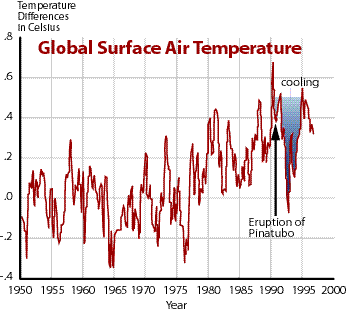|
Giant Volcanic Eruptions
In this alternate explanation of the loss of the dinosaurs, they
did not die out in an instant in some catastrophic disaster, but
over a period of a few million years of very stressful conditions.
These conditions were caused by a series of giant volcanic eruptions
that lasted for a long time --several million years, in fact. Even
in our time, large volcanic eruptions have been known to change
our weather--mostly by dumping vast amounts of sulfur into the upper
atmosphere. The sulfur changes into droplets of sulfuric acid which
are bright and reflect away the light of the Sun before it reaches
and warms Earth's surface. Consequently, the temperature on the
surface of Earth drops somewhat. Even a relatively small eruption
like that of Mount Pinatubo in the Philippines (pictured at the
top of this page) put enough sulfur into the air to cause a measurable
drop in temperature world-wide. Image:
Eruption of Pinatubo on June 12, 1991. Image courtesy of NOAA National
Data Center, NGDC.

This graph of
the Earth's average temperature changes since 1950 shows many ups
and downs, but the trend since about 1960 has been constantly upward.
(Many people think that is the result of Global Warming, but that
is another story!) Notice the big drop that lasted for about three
years starting in 1991. That is the effect of the eruption of Pinatubo.
The drop is only about half a degree, so most people didn't notice
it. But this change was caused by only one fairly small volcanic
eruption! Graph courtesy of Goddard
Institute for Space Studies.
In 1815, a much
larger eruption occurred at Tambora in Indonesia. This single volcano
put enough sulfur into the air to cause several degrees of cooling.
Enough to cause crop failures and starvation in France and northeastern
United Stated in 1816 and 1817!
What happened
to the dinosaurs? Imagine an endless series of super-Tamboras erupting
every few decades or centuries. Remember, hot-spot eruptions are
hundreds and thousands of times larger than even Tambora-size eruptions.
The result would be irregular periods of great cold every few decades
or centuries. Some scientists think that the eruptions poured enough
carbon dioxide into the air to cause long-term warming, so that
the weather would be alternating periods of unusually hot and cold
weather. Plants in different areas of the land would die, not all
at once, but during the long periods of poor weather. The excess
carbon dioxide might also have poisoned the oceans, causing marine
plants and animals to die. When the plants died, the local plant
eaters like triceratops and brachiosaurus soon died also, followed
by the meat eaters like T-Rex. Animals would be forced to migrate
or die. And often they died anyway.
Eventually,
the eruptions stopped and the weather returned to normal. But before
that happened, many of the Earth's plants and animals, including
the dinosaurs, were gone.
But now, the
question is is there any evidence that this is how the dinosaurs
died? There is an appropriately huge volcanic deposit that formed
at the right time: the Deccan Traps in India. You might look up
more information about volcanoes, the Deccan Traps, or "hot
spot" volcanism. Or watch a volcano erupt. What about the fossil
record? Did the dinosaur fossils end all at once, or do they slowly
fade out over a period of time? Is there any evidence of climate
change or stressed animals? There is much you can look for to test
this alternate explanation. Good Luck!
Back
|











